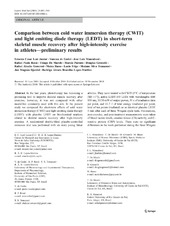| dc.contributor.author | Leal Junior, Ernesto Cesar Pinto | en_US |
| dc.contributor.author | de Godoi, Vanessa | en_US |
| dc.contributor.author | Mancalossi, José Luis | en_US |
| dc.contributor.author | Rossi, Rafael Paolo | en_US |
| dc.contributor.author | De Marchi, Thiago | en_US |
| dc.contributor.author | Bjordal, Jan Magnus | en_US |
| dc.date.accessioned | 2011-11-23T09:30:40Z | |
| dc.date.available | 2011-11-23T09:30:40Z | |
| dc.date.issued | 2010-11-19 | eng |
| dc.Published | Lasers in Medical Science 26(4): 493-501 | en |
| dc.identifier.issn | 0268-8921 | |
| dc.identifier.uri | https://hdl.handle.net/1956/5215 | |
| dc.description | There are 13 authors. Only a few of them have been given author entries in addition to the Collaboration. | en |
| dc.description.abstract | In the last years, phototherapy has becoming a promising tool to improve skeletal muscle recovery after exercise, however, it was not compared with other modalities commonly used with this aim. In the present study we compared the short-term effects of cold water immersion therapy (CWIT) and light emitting diode therapy (LEDT) with placebo LEDT on biochemical markers related to skeletal muscle recovery after high-intensity exercise. A randomized double-blind placebo-controlled crossover trial was performed with six male young futsal athletes. They were treated with CWIT (5°C of temperature [SD ±1°]), active LEDT (69 LEDs with wavelengths 660/ 850 nm, 10/30 mWof output power, 30 s of irradiation time per point, and 41.7 J of total energy irradiated per point, total of ten points irradiated) or an identical placebo LEDT 5 min after each of three Wingate cycle tests. Pre-exercise, post-exercise, and post-treatment measurements were taken of blood lactate levels, creatine kinase (CK) activity, and Creactive protein (CRP) levels. There were no significant differences in the work performed during the three Wingate tests (p>0.05). All biochemical parameters increased from baseline values (p<0.05) after the three exercise tests, but only active LEDT decreased blood lactate levels (p=0.0065) and CK activity (p=0.0044) significantly after treatment. There were no significant differences in CRP values after treatments. We concluded that treating the leg muscles with LEDT 5 min after the Wingate cycle test seemed to inhibit the expected post-exercise increase in blood lactate levels and CK activity. This suggests that LEDT has better potential than 5 min of CWIT for improving short-term post-exercise recovery. | en_US |
| dc.language.iso | eng | eng |
| dc.publisher | Springer | eng |
| dc.rights | Creative Commons Attribution Noncommercial License | |
| dc.rights.uri | https://creativecommons.org/licenses/by-nc/2.0 | eng |
| dc.subject | Skeletal muscle recovery | eng |
| dc.subject | Skeletal muscle damage | eng |
| dc.title | Comparison between cold water immersion therapy (CWIT) and light emitting diode therapy (LEDT) in short-term skeletal muscle recovery after high-intensity exercise in athletes—preliminary results | en_US |
| dc.type | Peer reviewed | |
| dc.type | Journal article | |
| dc.description.version | publishedVersion | en_US |
| dc.rights.holder | ©The Author(s) 2011 | |
| dc.identifier.doi | https://doi.org/10.1007/s10103-010-0866-x | |
| dc.identifier.cristin | 836173 | |
| dc.subject.nsi | VDP::Medical disciplines: 700::Sports medicine: 850 | eng |

